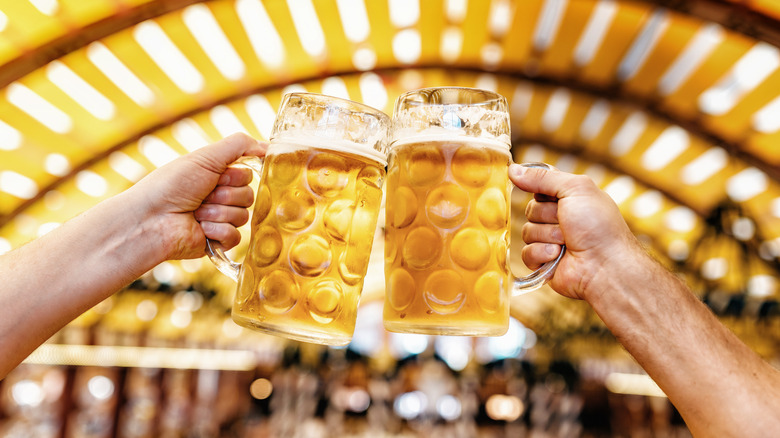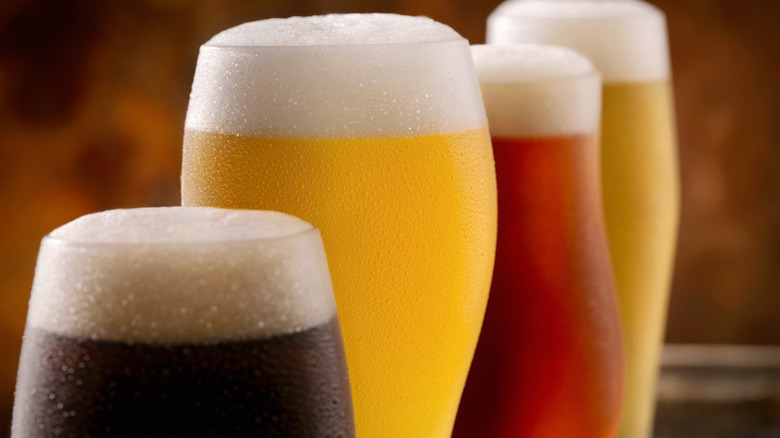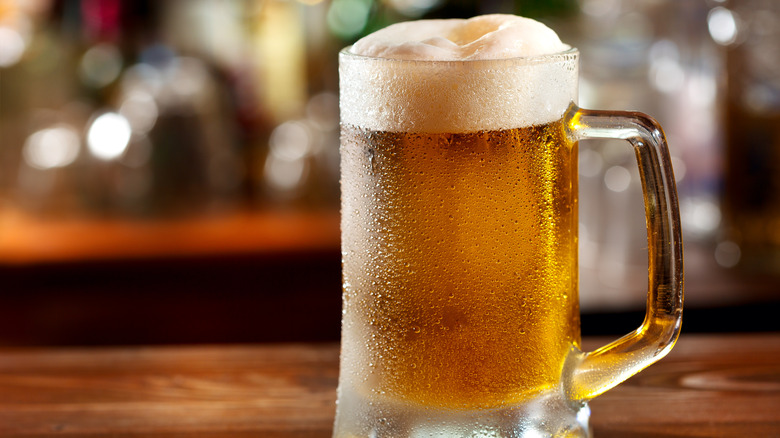There's A Reason Beer Mugs Are So Thick And Heavy
There's something satisfying about the way a heavy beer glass sounds when it clinks against another and then thuds back down on a bar counter or table. That's not the reason why beer mugs and certain kinds of beer glasses are so thick, but it is a wonderful bonus. No, the real reason for your sturdy beer glass is that glass thickness directly influences the temperature of your beer as you drink it.
Glass is a pretty good insulator, certainly more so than metal, but heat can still pass through glass. As you hold and drink a beer, the ambient air and your hand both warm the beverage inside the glass. The thicker the glass, the less thermal transfer there is and the longer your beer stays at the proper temperature. Larger pours of beer, like a pint, half-liter, or liter, are typically going to take longer to drink. In that timeframe, every time you pick up the glass to take a sip, the beer is at risk of warming up to the point that it is not quite as enjoyable to drink.
Thick, dimpled mugs and thick shaker pint glasses are going to provide more thermal protection against warming than thin-walled glass. That's why, generally speaking, larger glasses are thicker, and smaller glasses like tulips are thinner. It accounts for the temperature change your beer should face as you drink it.
Which beers should be served in thick glasses?
Glassware for beer is designed with two things in mind that dictate how your drink tastes. The shape of the glass affects your olfactory perception, and the thickness of the glass dictates the rate at which it warms.
Thinner glassware, like snifters and tulips, is best for high-alcohol beverages like imperial brews and barley wines. They benefit from being enjoyed warmer, and having glassware that encourages the beer to warm helps it open up — and precludes the necessity to keep those kegs at a different temperature than all the other beers on tap. Thicker glassware is made for beers that should stay closer to the temperature of the keg or bigger pours of heavy beers that could stand to warm up a bit but might take longer to drink.
Belgian dark ales, dubbels, strong lagers, tripels, and the like, are often served in heavy, thick goblets. Festbeirs, Czech lagers, and märzens are often served in handled mugs or steins. The most common standard bar glass, of course, is the pint glass. It might not be as thick as a stein, but it's still thicker than a tulip or, say, a Collins or highball glass. This is the best glassware for beers like pale ales, session stouts, pale lagers, ambers, browns, blondes, reds, and IPAs — beers that should stay cold while you drink them — or cask-conditioned beers, which are served around 55 degrees Fahrenheit and shouldn't get too much warmer.
Why is serving temperature so important for beer?
Certain beers should be enjoyed at certain temperatures. As reported by Wine Enthusiast, "Serve beer too cold and you won't be able to taste everything. Serve beer too warm and you might not enjoy drinking it!"
For the best tasting experience, the temperature of our tongues shouldn't drop below 71 degrees Fahrenheit. If the beer is too cold, it drops the temp of our mouths and the flavor can be masked. However, as beer warms, it loses the capacity to hold carbonation — which also reduces the ability to fully engage with the flavor, as the spritzing effect of carbonation helps to distribute aromatics — and can increase the perceived bitterness of hops. The fact is that warm, flat beer is pretty universally disappointing.
Beer should be served warmer than 34 degrees Fahrenheit, according to Wine Enthusiast, but generally, beer should come out of the tap at 38 degrees Fahrenheit. For the best drinking experience, pale lagers, dark lagers, pale ales, and IPAs should be enjoyed between 38 and 50 degrees Fahrenheit — although some brewers say you should drink IPAs as warm as 55 to maximize flavor. To maintain that range over the course of drinking the beer, a thicker glass is helpful to keep your 98.6-degree Fahrenheit body from making it go flat or bitter. Serving beer in an ice-cold glass helps on a hot day, too.


